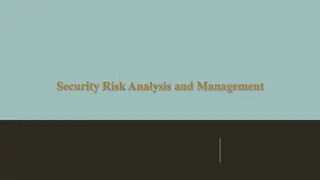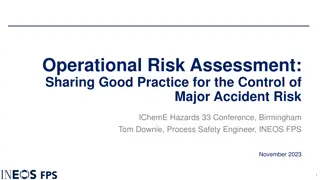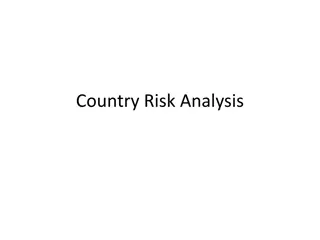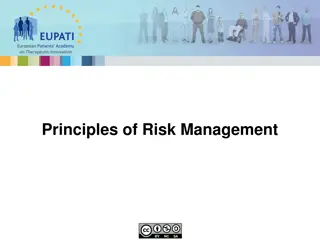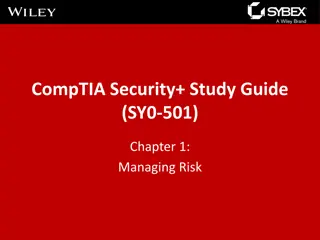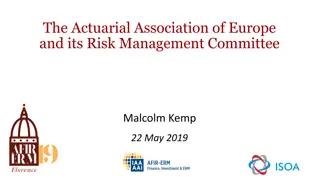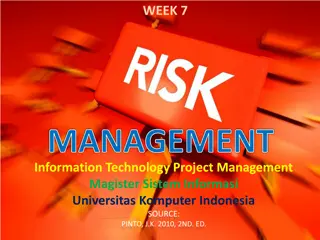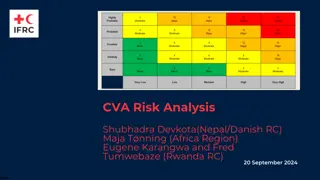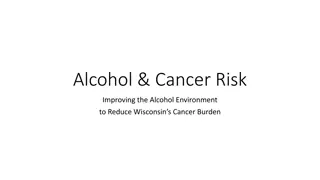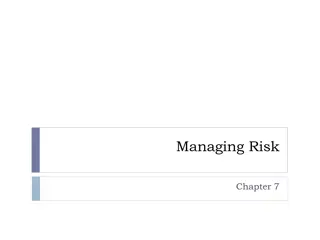
Effective Risk Management Strategies for Infection Prevention
This comprehensive guide outlines the key steps involved in risk management for infection prevention and control. It covers the four stages of risk management, including risk identification, analysis, control, and monitoring. By applying concepts of risk management, healthcare facilities can prioritize actions to reduce risks to the lowest practicable level. The approach is also applicable to hazards arising from the environment, equipment, and patient-related risks.
Download Presentation

Please find below an Image/Link to download the presentation.
The content on the website is provided AS IS for your information and personal use only. It may not be sold, licensed, or shared on other websites without obtaining consent from the author. If you encounter any issues during the download, it is possible that the publisher has removed the file from their server.
You are allowed to download the files provided on this website for personal or commercial use, subject to the condition that they are used lawfully. All files are the property of their respective owners.
The content on the website is provided AS IS for your information and personal use only. It may not be sold, licensed, or shared on other websites without obtaining consent from the author.
E N D
Presentation Transcript
Objectives December 1, 2013 1. Identify the four stages of risk management for infection prevention and control. 2. Develop a system for setting priorities for action based on risk management. 2
Time involved December 1, 2013 40 minutes 3
Risk Management December 1, 2013 Risk is defined as possibility of incurring misfortune and loss Primary aim of risk management is Proactive Reduction of risks to the lowest level that is reasonably practicable Ongoing process 4
Risk Management December 1, 2013 By applying concepts of risk management, the Infection Control Team can help healthcare facilities set priorities Aim is to Identify unsafe and hazardous practices Recommend cost effective preventive measures 5
Risk Management December 1, 2013 This approach can also be used for hazards or risks that arise from the environment or equipment, as well as patient-related risks 6
Four Stages of Risk Management December 1, 2013 1. 2. 3. 4. Risk identification Risk analysis Risk control Risk monitoring 7
Risk Identification December 1, 2013 Identify tasks and activities that put patients, healthcare workers & visitors at risk Identify the infectious agent(s) involved Identify the mode of transmission 8
Risk Analysis December 1, 2013 Why are infections happening? How frequently they are happening? What are the likely consequences if the appropriate action is not taken? How much they are likely to cost to prevent it? 9
Evaluating risks December 1, 2013 Compare level of risk found during the analysis process with previously established risk criteria Using statistical analysis Type I Type II Type III 10
Why Are They Happening? -Type I Error Sources of performance deficit These occur due to an act of omission Example: failure to comply with current professionally accepted practice Could be due to: Lack of knowledge Inadequate provision of education, training and supervision Lack of communication Lack of availability/regular supply of goods December 1, 2013 11
Why Are They Happening? - Type II Error Sources of performance deficit These occur due to an act of commission an act should not have been committed Could be due to: Lack of commitment Lack of consideration for others December 1, 2013 This is more complex and may also require management reinforcement 12
Why Are They Happening? Type III Error December 1, 2013 Occurs when we fail to understand the true nature of the problem Real solutions are adopted to deal with the wrong problems, rather than incorrect solutions to real problems Often due to lack of communication or misinterpretation of information 13
How frequently are they happening? December 1, 2013 This is quantitative information Can be achieved by on-going surveillance or by prevalence study Frequency can be measured as the percentage or rate of persons who developed infection If there are no infection data, probability can be used instead 14
Risk Probability -Frequency December 1, 2013 Rating 4 Probability 1: 10 Comments Almost certain or very likely to occur 3 1: 100 Highly probable that they will occur. 2 1: 1000 It is possible that they may occasionally occur 1 They are rare and do not believe/expect to occur 1: 10000 15
What are the likely consequences? December 1, 2013 Consequences are expressed by severity Severity is measured by morbidity/mortality of infection involved 16
Risk Probability - Severity December 1, 2013 Rating 20-30 Description High or major Consequence/Impact Major impact on patient which may lead to death or long term consequences Comments Urgent action is required 10-19 Moderate Moderate impact which may lead to short term consequences Action required 1-9 Low risk or minor Minimum impact with no or minor consequences Keep under review 17
Prioritising Risks December 1, 2013 18
Calculating Risk December 1, 2013 Risk Factor = Frequency (Probability) X Consequence (Impact) Surveillance data provides probability or frequency of infection from a task or a procedure Risk assessment provides impact or consequence to patient as a result of a task or a procedure 19
How much does it cost to prevent ? December 1, 2013 Estimated cost is important as it helps to target IP&C resources to specific procedure where risk was identified where they will deliver the greatest advantage in terms of preventing harm for patients Often it is not possible to have exact cost estimated cost is acceptable 20
Priorities for action December 1, 2013 Once all information on the severity, frequency of occurrence and cost of prevention are available Priorities for action can be calculating as follows: RISK RATING = SEVERITY x FREQUENCY 21
Priority for Action December 1, 2013 22
Risk Control -1 December 1, 2013 Put an agreed risk reduction plan in place in the problem area Eliminate risk, if possible Reduce risk to acceptable level, if needed Transfer risk to a third party May need to accept risk in short term 23
Risk Control -2 December 1, 2013 Identify Risks Analyse (Evaluate & Rank) Control Avoid Prevent Transfer Accept Risk Control : Think possible solutions ! How they can be avoided eg minimize/avoid use of sharps How they can be prevented eg use aseptic techniques Can it be transferred eg outsource waste management Can you accept it eg low risk/high cost intervention 24
Risk Monitoring Feedback and reporting To ensure that risk reduction plans are followed Performed by regular audit process surveillance outcome surveillance Feedback provided to relevant staff and senior management December 1, 2013 25
The audit process December 1, 2013 Audit process can identify infection risks When risk reduction plan in process, audit can identify new risks analyse risk against evidence-based practice identify any gaps in practice Key elements of the audit process communication consultation timely feedback 26
Summary: Risk Management December 1, 2013 27
References December 1, 2013 Roberts G. Risk Management in Healthcare. 2nd ed. London: Witherby & Co. 2002 Australian Standard: Risk management.AS/N2S 4360: 2004. http://www.mwds.com/AS4me_files/AS- NZS%204360- 2004%20Risk%20Management.pdf Australian Guidelines for the Prevention and Control of Infection in Healthcare (2010) http://www.nhmrc.gov.au/book/australian- guidelines-prevention-and-control-infection- healthcare-2010/a2-1-risk-management-bas 1. 2. 3. 28
Quiz December 1, 2013 1. Risk management is a retroactive approach and its aim is to minimise harm. T/F In setting priorities for action, which of these is needed? Severity or consequences Frequency Cost of implementing plans All of the above 2. a. b. c. d. 29
International Federation of Infection Control IFIC s mission is to facilitate international networking in order to improve the prevention and control of healthcare associated infections worldwide. It is an umbrella organisation of societies and associations of healthcare professionals in infection control and related fields across the globe . The goal of IFIC is to minimise the risk of infection within healthcare settings through development of a network of infection control organisations for communication, consensus building, education and sharing expertise. For more information go to http://theific.org/ December 1, 2013 30

